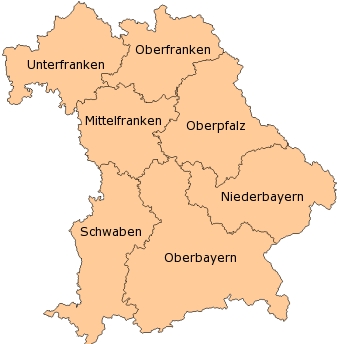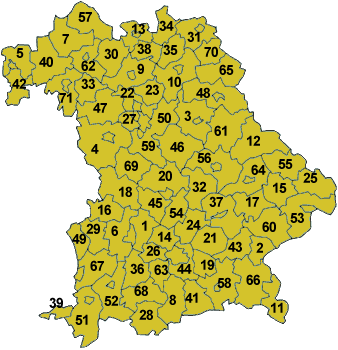Bavaria
|
|
| Flag | |
|---|---|
| Missing image Flag_de-bayern_lozenge.png Rautenflagge (flag, lozengy variant) | |
| Missing image Flag_de-bayern_striped.png Streifenflagge (flag, striped variant) | |
| Statistics | |
| Capital: | Munich (München) |
| Area: | 70,553 km² |
| Inhabitants: | 12.401.000 (08/2003) |
| pop. density: | 164 inh./km² |
| Homepage: | bayern.de (http://www.bayern.de/English/) |
| ISO 3166-2: | DE-BY |
| Politics | |
| Minister-president: | Edmund Stoiber (CSU) |
| Ruling party: | CSU |
| Map | |
| Missing image Germany_Laender_Bayern.png Federal states of Germany: Bavaria | |
With an area of 70,553 km² (27,241 square miles) and 12.4 million inhabitants, the Free State of Bavaria (German Bayern or Freistaat Bayern) forms the southernmost of the 16 states of Germany. Its capital is Munich.
| Contents |
Geography
Bavaria shares international borders with Austria and the Czech Republic. Neighbouring states within Germany are Baden-Württemberg, Hessen, Thuringia and Saxony. Two major rivers flow through the state, the Danube (Donau) and the Main.
The major cities in Bavaria are Munich, Nuremberg, Augsburg, Regensburg, Würzburg, Ingolstadt, Fürth and Erlangen.
See also: List of places in Bavaria.
Politics
Bavaria has a unicameral Landtag, or state parliament, elected by universal suffrage. Until December 1999, there was also a Senat, or Senate, whose members were chosen by social and economic groups in Bavaria, but following a referendum in 1998, this institution was abolished. The head of government is the Ministerpräsident.
Bavaria has long been a bastion of conservative politics in Germany, with the CSU having almost a stranglehold on power since its inception in 1946. Every Minister-president since 1957 has been a member of this party.
In the 2003 elections the CSU won more than two thirds of the seats in Landtag. No party in post-war German history had achieved this before.
Administration
Bavaria is divided into 7 administrative regions called Regierungsbezirke
- Oberfranken (Upper Franconia)
- Mittelfranken (Middle Franconia)
- Unterfranken (Lower Franconia)
- Schwaben (Swabia)
- Oberpfalz (Upper Palatinate)
- Oberbayern (Upper Bavaria)
- Niederbayern (Lower Bavaria)
These administrative regions consist of 71 districts (called Kreise) and 25 independent towns:
Districts:
Independent towns:
|
Dialects
Several German dialects are spoken in Bavaria. In the administrative regions to the north the Franconian dialect is prevalent, in Swabia the local dialect is Swabian, a thread of the Alemannic dialect family. In the Upper Palatinate people speak the Northern Bavarian dialect that can vary regionally. In Upper and Lower Bavaria (Middle) Austro-Bavarian is the predominant dialect.
History
Main article: History of Bavaria
The first known mention of the Bavarian name was made by the Franks ca. 520. Saint Boniface completed the people's conversion Christianity in the early 8th century. Bavaria resisted the Protestant Reformation, and remains strongly Roman Catholic.
Frederick I, Holy Roman Emperor gave Bavaria to the Wittelsbach family, which ruled from 1180 to 1918. It became a kingdom in 1806, and in 1815 the Rhenish Palatinate was annexed to it. It managed to preserve its independence by playing off the rivalries of Prussia and Austria, but defeat in the 1866 Austro-Prussian War led to its incorporation into the German Empire. In the early 20th century Wassily Kandinsky, Paul Klee, Henrik Ibsen, and other notable artists were drawn to Bavaria, notably to the Schwabing district of Munich, but the region was devastated by World War I.
Wieskirche1998.jpg
Socialist premier Kurt Eisner, who deposed Ludwig III, was assassinated in 1919 leading to a violently suppressed communist revolt. Extremist activity on the right also increased, notably the 1923 Beer Hall Putsch, and Munich and Nuremberg became Nazi strongholds under the Third Reich. As a manufacturing center, Munich was heavily bombed during World War II and occupied by U.S. troops.
Since World War II, Bavaria has been rehabilitated into a prosperous industrial hub. A massive reconstruction effort restored much of Munich's historic core, and the city played host to the 1972 Summer Olympics. More recently, state minister-president Edmund Stoiber was the CDU/CSU candidate for chancellor in the 2002 federal election, and native son Cardinal Joseph Ratzinger was elected Pope Benedict XVI in 2005.
See also: List of rulers of Bavaria, List of Premiers of Bavaria
Miscellaneous
The many famous Bavarians include:
- Pope Benedict XVI -- as of April 2005 he is the current Pope of the Roman Catholic Church. His baptismal name is Joseph Ratzinger.
- Painters such as Hans Holbein the Elder, Albrecht Dürer, Lucas Cranach and Franz Marc
- Musicians such as Richard Wagner, Richard Strauss and Theobald Boehm, the inventor of the modern flute.
- Modern musicians like Klaus Doldinger and Barbara Dennerlein
- Widely-read Bavarian writers like Bertolt Brecht, Lion Feuchtwanger
- Well-known scientists such as the Nobel prize winner Wilhelm Conrad Röntgen and Werner Heisenberg,also Rudolf Moessbauer and Robert Huber
- Well-known inventors such as Levi Strauss and Rudolf Diesel.
- Neurologist Alois Alzheimer, who described the disease bearing his name.
The motorcycle and automobile makers BMW (the name stands for Bayerische Motoren-Werke, or "Bavarian Motor Works") and Audi, Grundig (consumer electronics) and Siemens AG (electricity, telephones, informatics, medical instruments) have a Bavarian industrial base.
A famous annual festival is called Oktoberfest or October Festival. It is the largest public beer festival in the world, celebrated since 1811 during the two weeks leading up to the first Sunday in October.
Population and area
Regierungsbezirk population(2003) area (km²) municipalities Lower Bavaria .... 1,162,972 9.6% 10,330 14.6% 258 12.5% Lower Franconia .. 1,329,399 11.0% 8,531 12.1% 308 15.0% Upper Franconia .. 1,113,790 9.2% 7,231 10.2% 214 10.4% Middle Franconia . 1,678,535 13.9% 7,246 10.3% 210 10.2% Upper Palatinate . 1,069,121 8.8% 9,690 13.7% 226 11.0% Swabia ........... 1,773,688 14.4% 9,992 14.2% 340 16.5% Upper Bavaria .... 3,996,043 33.1% 17,530 24.8% 500 24.3% ------------------ ---------- ------ ------ ------ ---- ------ BAVARIA .......... 12,086,548 100.0% 70,549 100.0% 2056 100.0%ar:بافاريا
cs:Bavorsko da:Bayern de:Bayern et:Baieri als:Bayern es:Baviera eo:Bavario fa:بایرن fr:Bavière gl:Baviera ko:바이에른 id:Bayern it:Baviera he:בוואריה ka:ბავარია la:Bavaria nl:Beieren nds:Bayern ja:バイエルン州 no:Bayern pl:Bawaria pt:Baviera ro:Bavaria ru:Бавария simple:Bavaria sk:Bavorsko sr:Бајерн fi:Baijeri sv:Bayern ta:பவேரியா uk:Баварія zh:巴伐利亚


